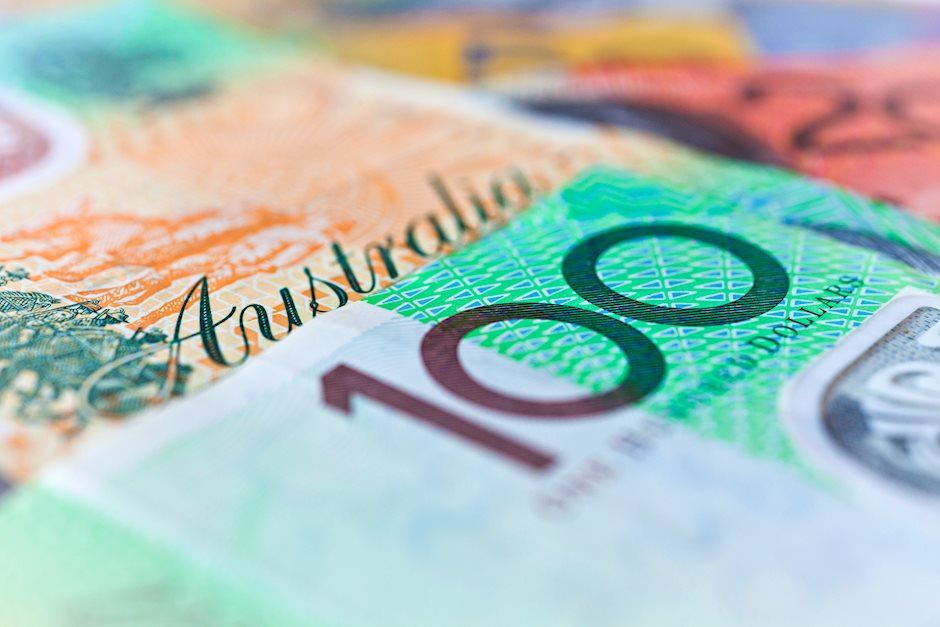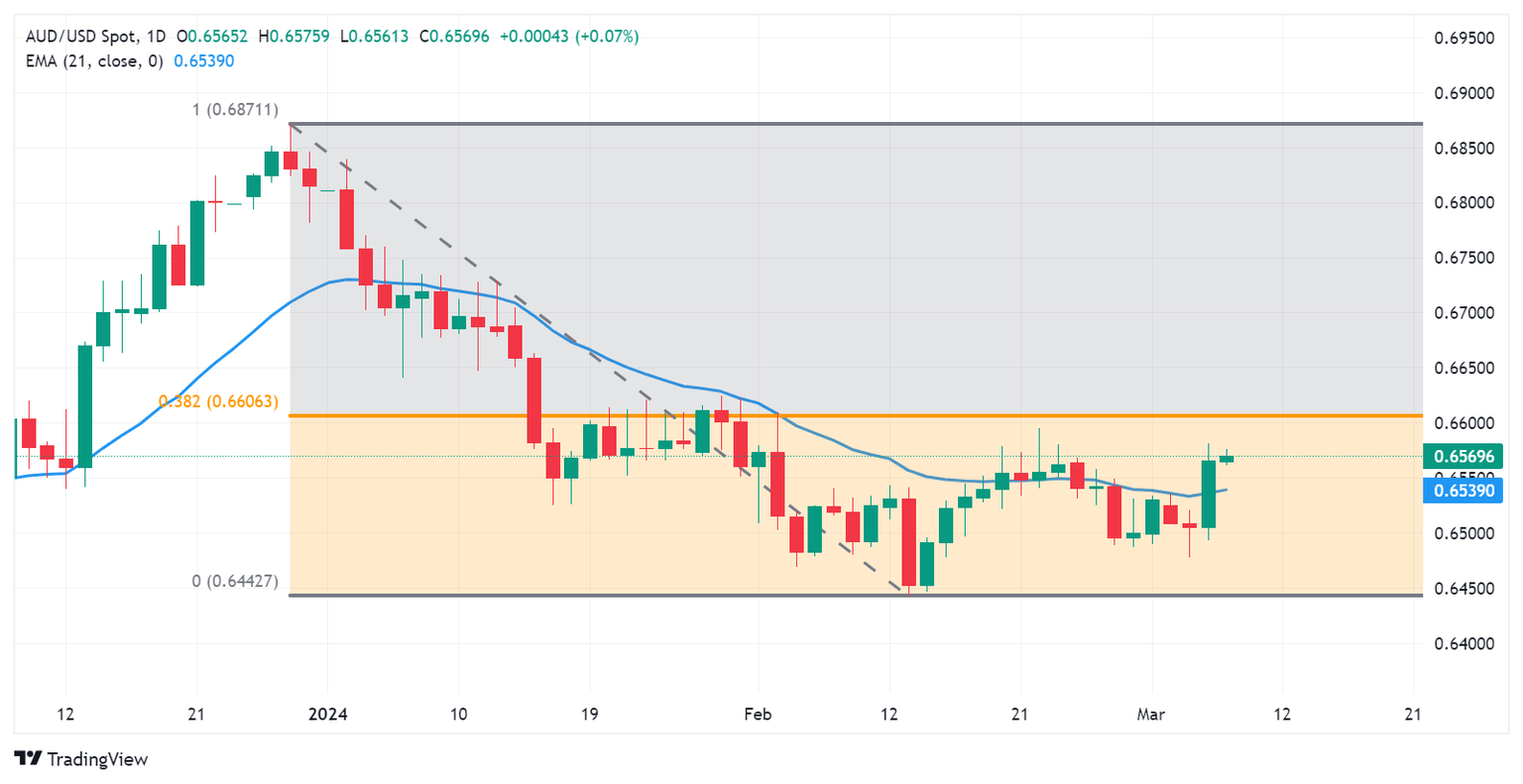Australian Dollar increased gains ahead of further remarks from Fed Chair Powell
- Australian Dollar appreciates on weaker US Dollar despite improved US Treasury yields.
- Australian Trade Balance (MoM) increased to 11,027M in February, slightly below the expected 11,500M.
- Chinese Trade Balance USD increased to $125.16B in February, against the expected $103.7B and $75.34B prior.
- Fed Chair Powell indicated that the central bank is prepared to lower borrowing costs "at some point this year."
- February’s US ADP Employment Change increased to 140K from 111K prior, falling short of the expected 150K.

The Australian Dollar (AUD) continues to advance for a second consecutive session on Thursday, largely driven by weakness in the US dollar (USD). This weakness stems from comments made by Federal Reserve (Fed) Chair Jerome Powell during his testimony before the House Financial Services Committee. Powell indicated that the Fed is prepared to lower borrowing costs "at some point this year," following the delivery of the semi-annual Monetary Policy Report. However, the recent escalation of the regional banking crisis in the United States (US) could potentially prompt Powell to expedite this process.
Australia's economy expanded less than expected in the fourth quarter, as shown by the latest Gross Domestic Product (GDP) data released on Wednesday. Moreover, the Trade Balance showed that the surplus fell short than expected. These outcomes limit the gains for the AUD/USD pair and support the case for the Reserve Bank of Australia (RBA) to adopt an easing bias. Furthermore, The Commonwealth Bank of Australia (CBA) has reaffirmed its forecast of 75 basis points in rate cuts for this year following the release of the disappointing GDP figures.
The US Dollar Index (DXY) experienced a decline driven by lower US Treasury yields. Federal Reserve Chair Jerome Powell stated that the US economy is not on the verge of a recession and anticipates inflation to gradually approach the 2% target. Powell emphasized the Fed's commitment to data-driven decisions, stating that interest rates would only be reduced when there is convincing evidence. Further insights from Powell are anticipated during his remarks on Thursday.
Daily Digest Market Movers: Australian Dollar appreciates on improved risk appetite
- Australian Trade Balance (MoM) showed that the surplus increased to 11,027M in February, from 10,743M prior. The market expectation was an increase to 11,500M.
- Aussie Imports (MoM) increased by 1.3% in February, from the previous figure of 4.8%. Monthly Exports grew by 1.6%, exceeding the previous rise of 1.5%.
- Australian Gross Domestic Product (GDP) grew by 0.2% QoQ in the fourth quarter of 2023, slightly below market expectations of no change at 0.3%.
- GDP (YoY) expanded by 1.5%, surpassing the expected 1.4%, but falling short of the previous growth of 2.1%.
- AiG Industry Index reported a print of -14.9 for January, compared to the -27.3 prior.
- Judo Bank Services PMI surged to a ten-month high of 53.1 in February. This increase pushed the index above the 50.0 threshold, indicating expansion, and surpassed the previous reading of 49.1.
- Australian Current Account Balance rose to 11.8 billion in the fourth quarter of 2023, against the expected 5.6 billion and 1.3 billion prior.
- Commerzbank economists anticipate that the Reserve Bank of Australia (RBA) will delay rate cuts, providing support for the Australian Dollar (AUD) in the interim. They do not foresee an imminent slowdown in the Australian economy. However, if clear indications of a slowdown emerge, possibly signaling a recession, the RBA may adjust its monetary policy stance sooner.
- Chinese Trade Balance USD increased to $125.16B against the expected $103.7B for February and $75.34B prior. Imports and Exports (YoY) rose by 3.5% and 7.1%, respectively.
- Former New York Fed economist Steven Friedman noted that Federal Reserve policymakers are likely to remain cautious about cutting interest rates this year due to strong growth and volatile inflation. He expected the possibility of fewer than the three cuts anticipated for 2024.
- Atlanta Federal Reserve (Fed) President Raphael Bostic made headlines on Monday, expressing uncertainty about achieving a soft landing. He does not foresee consecutive rate cuts when they commence but expects two 25-basis point rate cuts in 2024. While inflation is expected to return to the 2% target, Bostic believes it is premature to declare victory.
- According to the CME FedWatch Tool, there is a 5.0% probability of a 25 basis points rate cut in March, while the likelihood of cuts in May and June stands at 19.3% and 55.8%, respectively.
- February’s US ADP Employment Change came in at 140K against the expected 150K, increasing from 111K prior.
- January’s US JOLTS Job Openings fell to 8.863M from December’s figure of 9.026M, falling short of the market expectation of 8.900M.
- ISM Services PMI declined to 52.6 in February, against the forecasted downtick to 53.0 from 53.4.
- Factory Orders (MoM) decreased by 3.6% in January, exceeding the expected fall of 2.9%.
- S&P Global Composite PMI (Feb) increased to 52.5 from the previous reading of 51.4.
- US ISM Manufacturing PMI (Feb) dropped to 47.8 from 49.1, surprisingly missing the market expectation 49.5.
Technical Analysis: Australian Dollar rises to near 0.6570 before a psychological barrier
The Australian Dollar trades around 0.6570 on Thursday. Key resistance is noted near the psychological level of 0.6600, aligned with the 38.2% Fibonacci retracement level of 0.6606. A break above the latter could support the AUD/USD pair to explore the region around the major level of 0.6650. On the downside, the pair meet the major support at 0.6550 followed by the 21-day Exponential Moving Average (EMA) at 0.6539. A break below this level could prompt the AUD/USD pair to test the psychological level of 0.6500 before the previous week’s low at 0.6486.
AUD/USD: Daily Chart
(The story was corrected at 03:20 GMT on March 7 to say “Australian Trade Balance (MoM) increased to 11,027M in February” instead of “reduced to 11,027M” in the second bullet point and second paragraph).
Australian Dollar price in the last 7 days
The table below shows the percentage change of Australian Dollar (AUD) against listed major currencies in the last 7 days. Australian Dollar was the strongest against the Swiss Franc.
| USD | EUR | GBP | CAD | AUD | JPY | NZD | CHF | |
| USD | -0.58% | -0.59% | -0.49% | -1.32% | -1.39% | -0.80% | 0.34% | |
| EUR | 0.57% | -0.01% | 0.09% | -0.73% | -0.81% | -0.21% | 0.91% | |
| GBP | 0.59% | 0.01% | 0.09% | -0.72% | -0.80% | -0.21% | 0.93% | |
| CAD | 0.48% | -0.07% | -0.10% | -0.83% | -0.91% | -0.31% | 0.82% | |
| AUD | 1.29% | 0.72% | 0.70% | 0.81% | -0.09% | 0.51% | 1.62% | |
| JPY | 1.37% | 0.81% | 0.78% | 0.87% | 0.07% | 0.60% | 1.71% | |
| NZD | 0.78% | 0.21% | 0.21% | 0.31% | -0.51% | -0.60% | 1.15% | |
| CHF | -0.34% | -0.91% | -0.93% | -0.83% | -1.67% | -1.74% | -1.14% |
The heat map shows percentage changes of major currencies against each other. The base currency is picked from the left column, while the quote currency is picked from the top row. For example, if you pick the Euro from the left column and move along the horizontal line to the Japanese Yen, the percentage change displayed in the box will represent EUR (base)/JPY (quote).
Australian Dollar FAQs
What key factors drive the Australian Dollar?
One of the most significant factors for the Australian Dollar (AUD) is the level of interest rates set by the Reserve Bank of Australia (RBA). Because Australia is a resource-rich country another key driver is the price of its biggest export, Iron Ore. The health of the Chinese economy, its largest trading partner, is a factor, as well as inflation in Australia, its growth rate and Trade Balance. Market sentiment – whether investors are taking on more risky assets (risk-on) or seeking safe-havens (risk-off) – is also a factor, with risk-on positive for AUD.
How do the decisions of the Reserve Bank of Australia impact the Australian Dollar?
The Reserve Bank of Australia (RBA) influences the Australian Dollar (AUD) by setting the level of interest rates that Australian banks can lend to each other. This influences the level of interest rates in the economy as a whole. The main goal of the RBA is to maintain a stable inflation rate of 2-3% by adjusting interest rates up or down. Relatively high interest rates compared to other major central banks support the AUD, and the opposite for relatively low. The RBA can also use quantitative easing and tightening to influence credit conditions, with the former AUD-negative and the latter AUD-positive.
How does the health of the Chinese Economy impact the Australian Dollar?
China is Australia’s largest trading partner so the health of the Chinese economy is a major influence on the value of the Australian Dollar (AUD). When the Chinese economy is doing well it purchases more raw materials, goods and services from Australia, lifting demand for the AUD, and pushing up its value. The opposite is the case when the Chinese economy is not growing as fast as expected. Positive or negative surprises in Chinese growth data, therefore, often have a direct impact on the Australian Dollar and its pairs.
How does the price of Iron Ore impact the Australian Dollar?
Iron Ore is Australia’s largest export, accounting for $118 billion a year according to data from 2021, with China as its primary destination. The price of Iron Ore, therefore, can be a driver of the Australian Dollar. Generally, if the price of Iron Ore rises, AUD also goes up, as aggregate demand for the currency increases. The opposite is the case if the price of Iron Ore falls. Higher Iron Ore prices also tend to result in a greater likelihood of a positive Trade Balance for Australia, which is also positive of the AUD.
How does the Trade Balance impact the Australian Dollar?
The Trade Balance, which is the difference between what a country earns from its exports versus what it pays for its imports, is another factor that can influence the value of the Australian Dollar. If Australia produces highly sought after exports, then its currency will gain in value purely from the surplus demand created from foreign buyers seeking to purchase its exports versus what it spends to purchase imports. Therefore, a positive net Trade Balance strengthens the AUD, with the opposite effect if the Trade Balance is negative.
Author

Akhtar Faruqui
FXStreet
Akhtar Faruqui is a Forex Analyst based in New Delhi, India. With a keen eye for market trends and a passion for dissecting complex financial dynamics, he is dedicated to delivering accurate and insightful Forex news and analysis.


















